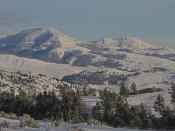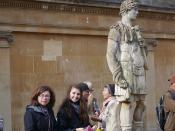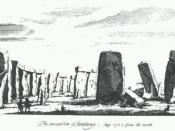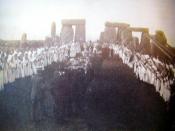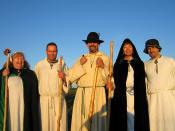Templa Druidum "The mazes of wild opinion [about Stonehenge] are more complex and intricate than the ruin"ÃÂ (Mass 8). There couldn't have been a better way to perfectly sum up Stonehenge's mysterious and ambiguous history than the way this observant visitor described it. The name Stonehenge can be traced back to words meaning "circle of stones"ÃÂ, "hanging stones"ÃÂ, or "stone hinges"ÃÂ (8). Henry of Huntingdon is credited with the first known account of this word in its Latin form "Stanenges"ÃÂ (8-9). Henry of Huntingdon stated, "Stanenges, where stones of wonderful size have been erected after the manner of doorways, so that doorway appears to have been raised upon doorway; and no one can conceive how such great stones have been so raised aloft, or why they were built there"ÃÂ (9). Stonehenge's landscape contains possibly the largest accumulation of prehistoric burial mounds in the world (9). Stonehenge's construction is estimated to have begun around 3100 BC to 1100 BC (10).
Stonehenge was originally only a single building that consisted of walls but never had a roof. It was believed that it was in a constant state of construction throughout its usable period (9-10). Stonehenge is located about thirty miles north of the English Channel and eighty miles west of London in a county called Wiltshire (Chippindale 10). Originally, Stonehenge was constructed from an estimated 162 stone blocks of various sizes (10). The giant sandstone uprights, called sarsens, are the most commonly recognized stones of the remnants of Stonehenge. They are thirteen and one-half foot tall, seven foot wide, and three and three-fourths foot deep (12). The summer solstice was is a big attraction to a lot of the people who visit Stonehenge. As Terence Meaden stated, "The story of the beliefs of the Stonehenge People at the time of the summer solstice is compelling and dramatic: it involves the celebration of life in a way that everybody who is close to nature and appreciates the human condition can understand"ÃÂ (Meaden 11). The question that is still left to be answered is, who could have created this great monument and why? "Druids were involved in politics, sacrificial ritual, prophecy and the control of the supernatural world. Like the prophets of the Old Testament, they were feared and venerated because they had the ear of the divine world"ÃÂ (Green 7). Basically, the Druids were a regular structured prehistoric society, with strict religious undertones, that kept history by word of mouth. The typical Druid was believed to wear long white robes, have short curly hair, and have a short beard as seen in the figurines that have been found that model the Druids (58). Also, the Druids wore large, golden necklaces called torcs (58). The earliest accounts on the Druids were from the Greeks and Romans. The main writers of these accounts were Strabo, Diodorus Siculus, and Julius Caesar (14). Caesar who was appointed to the Roman Senate as governor gave some of the most detailed accounts of the ancient Druids (10). In one of his accounts he stated that; "The Druids are concerned with the worship of the gods, look after public and private sacrifice, and expound religious matters"ÃÂ (10). The Romans and Druids had many altercations with each other due to their disagreements in religious matters. In fact, Caesar, of the Roman Senate, described the Druids as sinister and sadistic priests of human sacrifice (Chippindale 83). The Druids played an instrumental role in the creation, use, and preservation of the Stonehenge monument.
"It has mistakenly and pessimistically been said that we can never know the religion of those forgotten peoples. The ancient Britons left us nothing in writing, no sagas, no know traditions; their period of activity was so long before the beginning of recorded history that might seem that nothing of potential use has come down to us. Nonetheless, the clues are there, and as one searches, so they multiply"à(Meaden 14). As seen in the passage, the Druids were the first known people to be in area of Britain. How long they were there is not known because recorded history does not date back that far. Therefore it is hard to disprove the fact that, since the Druids were the only known habitants of this area, they undoubtedly play a key role in at least the early construction of Stonehenge. John Aubrey was credited with writing the first modern book in the 17th and 18th century that formally linked the Druids to the creation and occupation of Stonehenge. The book was entitled the Monumenta Brittannica, but the book was never completed during his lifetime. William Stukeley, Aubrey's predecessor, did continue Aubrey's works after his death (Chippindale 71). John Aubrey once said, "So it is clear, that all the monuments which I have here recounted, were temples; now my presumption is, that the Druids being the most eminent priests among the Britaines"æ"à(Green 144). This quote shows the logic behind Aubrey's theory behind the Druids creation of Stonehenge. His theory coincides with the thoughts of modern writer Terence Meaden's thoughts. Meaden said that the main inspiration of the creation of Stonehenge had to do with worship and religion (Meaden 13). Combine this with the thoughts by Aubrey of the Druids being the priests of the Britaines and the religious conflicts between the Romans and Druids, and this gives you the Druids possible central reason for building Stonehenge. An argument against the Druids use of Stonehenge is that it was used as an astrological marker device. This is very unlikely because on of two explanations. The happening of the summer solstice could have just been a coincidence as most people are surprised to know that the solstice does not perfectly align with the "Heel Stone"àas once believed. It is actually many degrees off of a perfect alignment (99). Another possible answer to this argument is that fact that the Druids religion was believed to consist of many different Gods. An event such as the solstice could have been enough to convince the Druids that it was a sign of the gods and therefore the Druids may have built Stonehenge in such a manner as to worship this happening.
"Let us imagine what kind of a countrie this was in the time of the ancient Britons"æ a shady dismal wood: and the inhabitants almost as savage as the beast whose skins were their only raiment"æ Their religion is at large described by Caesar. Their priests were Druids. Some of their temples I pretend to have restored, as Avebury, Stonehenge etc"æ They were two or three degrees I suppose less savage than the Americans"æ The Romans subdued and civilized them"à(Green 140). In the aforementioned quote of John Aubrey's, he tells about the Roman and Druid conflict at and around Stonehenge and other temples. Aubrey talks about the Druids as the Romans saw them. The Romans saw the Druids as pagan, cruel, sadistic people who held no morals and were basically barbarians. The Romans in an act to stop the Druids' worship purposely destroyed many of the Druids' temples including the partial destruction of Stonehenge (14). This proves the fact that the Druids used Stonehenge for their worship. Dr. William Stukeley, who was influenced by Aubrey's Templa Druidum, eventually became obsessed with the task of proving that there was a druidic connection to Stonehenge to all of the skeptics that opposed him (Chippindale 82). In his quote he stated, "I cannot but suppose "ÃÂem to have been an heathen temple of our Ancestors, perhaps in the Druids' time"à(Green 144). Ever since John Aubrey, in 1649, stated in the Monumenta Brittannica that the Druids worshipped at Stonehenge it has been accepted by many as the truth (Witcombe 1). Stukeley, in the same light, reported his similar theory in his book entitled Stonehenge, published in 1740 (Green 142). At temples such as Stonehenge there have been many accounts of finding animal and human remains, which were found to date back to a time near that of the Druids presence in the area (Mass 30-31). Many Druids believe that the evidence was stolen from the sight that could have solidly linked the Druids to Stonehenge, but records of the digs that may have uncovered such artifacts were too vague to come to any sure conclusion (65). Secular Arch Druid Tim Sebastian say the Duke of Buckingham "Desecrated the center of Stonehenge, where many items were dug up and stolen; they included precious metal Druidic ritual ornaments, a golden cape of an Arch Druid and a ritual silver-tipped ram's horn"à(65).
In modern times, the Druids remain still an intricate part of the Stonehenge legacy, which makes the Druidic connection to Stonehenge that much stronger. Why would a group such as this participate in the restoration and celebration of this great monument if they did not somehow have a common link to it? Modern sects of the Druidic culture were often found to be branches spawned from conflicts in other Druidic orders (Witcombe 2). The longer lasting and more mystical sect, the Ancient Order of the Druids, lasting throughout the 19th and 20th centuries, and it boasted a celebrity membership including it's most famous member, Winston Churchill (2). The Ancient Order of the Druids has held there summer solstice celebration there for a long time and still to this day go to Stonehenge to celebrate annually (2). Other groups often have ceremonies at Stonehenge such as; The Order of Bards, Ovates, and Druids (OBOD) and A Druid Fellowship (ADF) (Green 170-171). The most influential piece of evidence for the Druids continued involvement in Stonehenge is their continued involvement in the restoration and preservation of Stonehenge. Today, due to human interaction and natural erosion, Stonehenge has been greatly altered from its once magnificent state (Meaden 92). There was once a period in its history where the public was taking hammers to the stone in order to get themselves a souvenir of Stonehenge (92). In the early 1900's destruction of Stonehenge was so bad the owners were forced to charge admission to cut down on the destruction of the monument (Witcombe 2). Less than half of the original stones that built Stonehenge still stand today (Mass 74-78). The overall aging and weathering, along with various graffiti, of Stonehenge has literally turned it into a ruin (74-78). In 1901, partly privately funded by certain Druidic sects a restoration was started in hopes to preserve Stonehenge for future generations (79-80). This shows the Druids continuing dedication to the place that their ancestors once created and worshipped at.
"If only the builders of Stonehenge could see it now, they would marvel, too, not at the poignancy of the beautiful ruin, but because of the perpetual puzzlement it brings"ÃÂ (Meaden 14). Only further research will ever tell the true origin of Stonehenge and the ancient culture that used it and created it. Without a doubt, the Druids, as reflected through the many first hand accounts in this paper, played a significant role in the creation, use, and preservation of Stonehenge. Stonehenge may never tell the true story that it holds inside its stones, and the human race maybe never know exactly who created Stonehenge and why it was created. Some things are better left up to one's own imagination. For the logical thinker, though, it is significantly possible that the Druids were the creators and users of Stonehenge.
